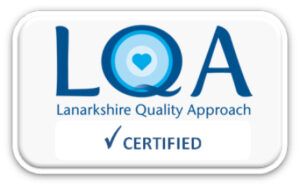Puree Diet
Information for patients
NHS Lanarkshire Dietetic Department
PIL.PUREA4.64609.L
If you are having difficulty chewing or swallowing, puréed foods may be easier to manage. Pureéd food should be lump free e.g. the smooth texture of mashed potato.
This leaflet can help you choose suitable foods, adapt your own dishes and help get the most nourishment from your meals.
If you have been diagnosed with a swallowing difficulty and/or are under the care of a Speech and Language Therapist please refer to your Dietitian for swallow related specific advice.
Equipment
You will need one of the following for puréeing food:
- A liquidiser.
- A food processor.
- A hand-held blender. This is ideal for small quantities and is a less expensive option.
Puréeing Your Food
- Most food can be puréed.
- Extra liquid will probably be needed to get the correct consistency and ensure the meal is not too dry.
- Ensure a smooth purée by liquidising small quantities at a time. You may need to sieve to remove any pips, lumps or skins etc still left.
- Purée foods separately (i.e. vegetables separate from meat or fish) and arrange individually on the plate. A plate with dividers can be useful to prevent food from running into each other.
- Think of the colours of the various items of food when you plan your meal. Combine a bright, coloured vegetable with a paler food e.g., carrots or peas with creamed potato, and chicken in a creamy sauce.
- To stimulate the appetite try to vary the flavours in the meal. Use spices, herbs and a variety of sauces e.g. soy, worcester, tomato, barbeque, curry, mint, parsley sauce or pasta sauces.
- Food moulds are available to buy in a range of shapes which can make pureed food more visually attractive and interesting to eat. This will improve the meals presentation overall and further stimulating the appetite.
Examples of Puréed Options
Cooking and puréeing food can be time-consuming. Not everything needs to be prepared from scratch – many different convenience foods can be used. Here are some ideas:
Breakfast Cereals:
Instant oat cereals, Weetabix – add sufficient hot or cold milk to achieve the correct consistency. Eat these anytime. Serve topped with cream, sugar, golden syrup or jam.
Meat/Chicken/Fish:
Most meat dishes or fish dishes can be puréed successfully.
If necessary serve with an extra jug of gravy or sauce. This could be thickened with some mashed potato or instant potato powder.
Ready-to-Eat Meals:
Tinned, packet, frozen or boil-in-the-bag can be reheated according to the instructions on the packaging and then liquidised.
Potatoes and Vegetables:
Instant or frozen mashed potato is useful not only as mashed potato but also in powder form as a thickener for other puréed dishes.
Add grated cheese and/or butter or milk to improve the flavour.
To make meals more appetising creamed potato can be formed into nests with puréed meat and vegetables served in the middle.
Many vegetables can be puréed after being cooked or heated from a tin. Suitable ones include carrots, turnips, parsnips and cauliflower.
If they have skins (e.g. peas, or beans) it may be necessary to sieve them.
Tinned and Packet Soups:
These are not always very nutritious. Make up the soup with full cream milk rather than water and/or add some cream to enrich or use. Avoid croutons.
Sauces/Gravy Mixes:
Granules, tinned and packet mixes or jars of pasta sauce are all useful to add flavour and variety.
Fruit:
Fruit juices are the easiest way to take fruit and ensure an adequate intake of Vitamin C.
Fruits can be stewed and puréed (e.g. apple, apricots) and tinned fruits easily puréed with their syrup (pineapple is not suitable).
Desserts:
There are many suitable instant puddings on the market e.g. Angel Delight, pots of mousse, thick and creamy yoghurt and fromage frais (avoid those with fruit pieces), or ready-made custard.
Tinned rice pudding can be puréed and given extra flavour with seedless jam. Sweet sauces (available in jars or tubes) such as chocolate, strawberry, butterscotch, and maple syrup can be used to add variety to basic desserts such as ice-cream, milk puddings and mousses.
A lightly mashed banana with some cream, evaporated milk, or runny honey makes a quick snack or dessert.
Stewed and puréed apple with custard or puréed rice pudding, ice-cream, cream or Greek yoghurt.
Sponge cake can be soaked with fruit juice and served with evaporated milk or cream to provide a nourishing pudding.
To Help Maintain Weight
Puréed meals can be bulky and very filling especially if your appetite is small. It is important to make them as nourishing as possible. Here are some suggestions:
- Eat little and often. Try having three small meals with three mid-meal snacks daily.
- Use high energy liquids when extra fluid is required to give the correct consistency. Full fat milk, creamy sauces, thickened gravy, custard or juice will add extra calories to the meal. Do not use water.
- Add high energy foods whenever possible. Butter, margarine, milk powder, grated cheese, evaporated milk, sugar, double cream, jam, syrup and honey are all useful.
- Use full fat foods not diet varieties of yoghurt, fromage frais, milk, spreads (butter/margarine). Try to avoid skimmed/semi-skimmed milk, any product labelled fat free/low fat/light or low-calorie slimming foods. Reduced sugar/sugar free should be avoided unless you have diabetes.
- Add sugar to your foods and drinks where possible unless you have diabetes.
- Fortified milk doubles the goodness of milk without doubling the amount you need to drink. It can be used to make porridge, cereal, milk drinks, milk puddings, mashed potato, packet or condensed soups.
Fortified milk is made as follows:
- 1 pint full-cream milk plus
- 4 tablespoons dried skimmed milk powder with added vegetable fat whisked together.
Fortified drinks such as Complan and Meritene can be bought from the pharmacy or supermarket. They are useful as between meal or bedtime drinks.
Diarrhoea/Constipation
Diarrhoea or Constipation can be a problem for people following a puréed diet. This may be because:
- Not enough high fibre foods are being eaten – liquidising does not destroy the fibre in foods. Use wholegrain cereals such as Weetabix, digestives “dipped” in tea or coffee, all types of fruit and vegetables (particularly prunes).
- Fluid intake is not sufficient – aim for at least 6-8 cups of fluid per day. It is even more important to drink adequate fluid if you are taking a high fibre diet.
Cooking in bulk and freezing foods
If you have a freezer you may find it convenient to make up a large quantity of some dishes and then divide into single portions to be frozen.
Clean empty yoghurt pots, or margarine tubs are ideal for this: cool the food quickly after cooking and freeze immediately. Don’t forget to label and date the pots.
Defrost the portions thoroughly at room temperature or in the microwave, then reheat. Food should not be reheated more than once because of the risk of food poisoning and defrosted food should never be refrozen.
Sample menu
Breakfast:
- Sweetened fruit juice
- Porridge made with fortified milk (add sugar or honey)
- Thick and creamy yoghurt
Mid Morning:
- Biscuits dipped in a milky coffee
Lunch (light meal):
- Puréed vegetable soup
or
- Sieved baked beans with mashed potato
- Fruit fool (fold pureed stewed fruit into sweet custard) or chocolate mousse.
Mid afternoon:
- Fortified milky drink/high calorie milk shake
Evening Meal:
- Puréed meat
- Puréed vegetables
- Creamed potato with added butter
- Milk pudding (made with fortified milk) add puréed fruit or seedless jam
Bed Time:
- Fortified milky drink
- Weetabix (made with hot or cold fortified milk)
Pub. date: June 2022
Review date: June 2024
Issue No: 06
Reference: PIL.PUREA4.64609.L
22_07362
If you need this information in another language or format, please e-mail:





